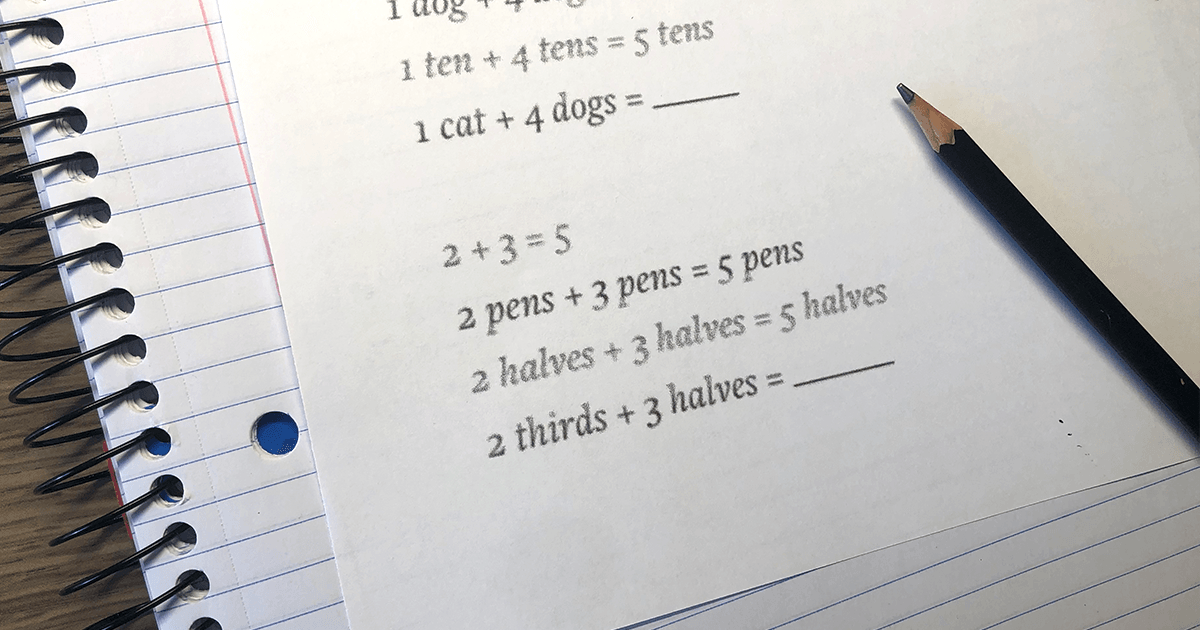Posted in: Aha! Blog > Eureka Math Blog > Conceptual Understanding > Precise Fraction Language
Strategy
Old habits die hard. I get it. During a recent power outage, I had to laugh at how often I’d enter a room and flip the switch knowing full well that nothing would happen. I can understand how teachers often forget about how important it is to use precise language during math instruction. We’ve gotten so used to saying certain things that it’s hard, in the midst of all that teachers do, to recall, for example, that a fraction can be “expressed in its simplest form” rather than “reduced”. Maybe if we had a clearer understanding of why certain phrases or terms are preferable to others it would encourage us to more regularly use precise and accurate language.
Reducing Fractions
I’m not sure where the term “reduced fraction” comes from and it really doesn’t matter. What I do know is that outside the context of math, the word “reduce” means to make smaller. If your boss told you your salary was going to be reduced, I’m sure you wouldn’t interpret the statement to mean that your paychecks would now be expressed in simplest form! I also know that it’s common for a student to be confused by an equation showing:

Visually students can see that the value of the digits in both the numerator and the denominator have become smaller, so it’s difficult initially to understand that these fractions are, in fact, equivalent. Combine that with the fact that a student’s teacher may be saying, “the fraction 3 sixths can be reduced to 1 half,” and you can see why a student would have further reason to be confused by the equation shown. Therefore, phrases like, “rename it in its simplest form” or “rename it using the largest units possible” are more likely to help students deepen their understanding of fractions.
Improper Fractions
Another term that is used too frequently is “improper fraction.” Of course, improper fraction is a mathematically correct term used to describe a fraction like 5/3, where the numerator is larger than the denominator. Likewise, a fraction where the numerator is smaller than the denominator, like 2/7, is called a “proper fraction.” Yet how often do we say that? The point is, just because it’s correct to say something doesn’t mean it’s helpful for a student to hear it repeatedly. Again, what does the word “improper” mean outside of a math context? Wrong! Incorrect! Not right! I can vividly recall the many times when students would calculate a sum or product, which resulted in a fraction greater than one (e.g., 7/4) and they’d think, “that’s an improper fraction, I must’ve done something wrong.” Instead, call them “fractions greater than 1.” In doing so you’ll let students know that there is nothing incorrect about these numbers, and also remind them that these fractions have a value that is greater than 1.
Common Denominator
In order to add and subtract fractions we need to have common denominators. However, when multiplying fractions common denominators are not necessary. When dividing fractions common denominators are helpful but not necessary. While all of this may be true, is it necessary to express to students? By articulating all of these rules for fractions, we’re inherently telling students that fractions are different: they can’t be counted or operated like whole numbers and are more difficult to work with when solving problems. The truth is, fractions are numbers and they can be counted, manipulated, renamed, and operated just like whole numbers.

Notice that in both of the sequences above, in order to complete the final number sentence, one must rename and find a common unit. For example, cats and dogs can be renamed as pets or animals, and then added. Likewise, thirds and halves can be renamed as sixths or twelfths and then added. The phrase, “common unit” therefore applies to both whole number and fraction operations. It also helps students see and hear that fractions are numbers too and they don’t require their own set of rules!
Submit the Form to Print

Adam Baker
Topics: Conceptual Understanding










